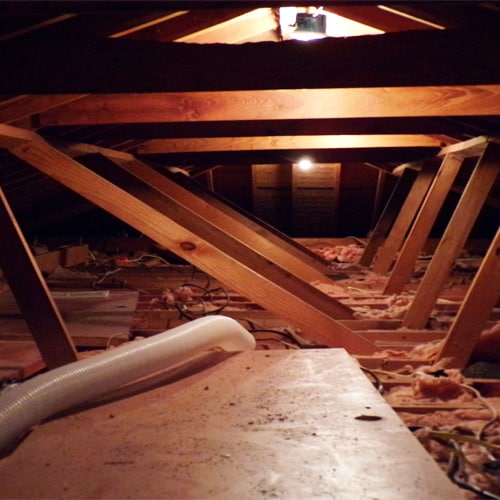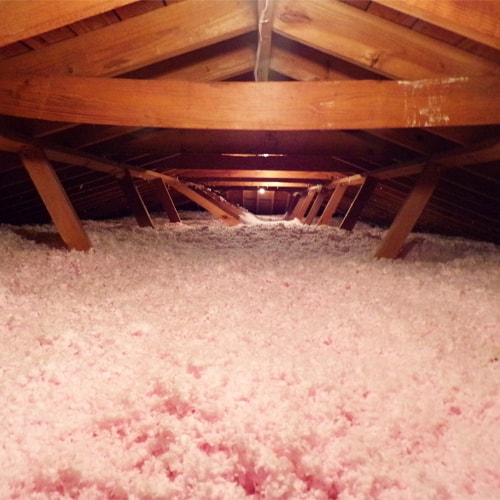How Much Attic Insulation Do I Need?
It might not seem obvious, but your home’s attic insulation can be a real life-saver. If it’s hot outside, insulation helps keep the cool air indoors.
In the colder months, insulation does just the opposite by holding the warm air in and keeping the cool air at bay. On top of that, great insulation can also keep loud sounds to a minimum.
So, if you’re looking for a cost-effective solution to keep your home the right temperature (and sound level) year-round, then you might want to consider new attic insulation.
What Is Attic Insulation?
Generally speaking, wood, drywall, and other building materials are thin and end up leaking out your heated or cooled air. Insulation provides an extra layer (of foam or fiberglass) that helps your house keep all that air conditioning inside. In the winter months, you might think of insulation like a thick wool sweater for your home.

In today’s homes, common places for insulation include between the walls, down in the crawl space or under your flooring (depending on your foundation type), and up in the attic.
Without getting too technical (yet!), attic insulation is simply the insulation that gets installed up in your attic to help your home maintain energy efficiency and temperature control.
How Is Attic Insulation Graded?
What you may not know is that there are different types of insulation. They’re typically made of a foamy material that gets measured (or “graded”) in something insulation experts call its R-value.
What is R-value exactly? Honestly, it’s just a fancy industry term that means “overall heat performance”. (But now you can throw this into your next Zoom call to impress the fam!)
The higher your attic’s R-value is, the better it will be at controlling heat flow. As a result, the different kinds of insulation then get installed in certain areas in the home based on their materials and R-value. In the attic, the more common types of insulation are blown in cellulose, loose-fill fiberglass, or fiberglass batts.
Why Do I Need New Attic Insulation?
Chances are good that your current attic already has insulation installed. In existing homes, it was probably there when you moved in. If you built a new home, then your contractor team would have made sure to install insulation in all the necessary places, including your attic.
So, you may be asking, “Why would I need new attic insulation?” It’s a very good question, and one that we get a lot.
Here’s the simple answer: If your current attic insulation is not correctly installed, your home can experience consistent air leaks that reduce your overall energy efficiency. The same is true of old, less efficient insulation. By upgrading your attic insulation, you improve overall energy performance and lower your A/C bill at the same time.

How Much Does Attic Insulation Cost? And How Much Insulation Do I Need in My Attic?
These questions are related and very difficult to answer in a general way, due to the wide number of differences from one home to another. Two homes right next to each on the same block can be wildly different in terms of size and style.
Because of this, the cost of an attic insulation will vary widely, depending on a number of factors: size of the attic, age of the home, geographic location, budget, and other things. It’s like trying to estimate the average cost of furnishing a new home. Houses vary in size, style, design aesthetic, among countless other factors.
In other words, to get a fair estimate, you really need a local attic insulation specialist to come by and take a look. An on-site inspection is just about the only way to get an accurate price quote.
That being said, the upfront cost of new attic insulation can be more than made up for by the lower energy bills you’ll be paying for months down the road. In fact, a study run by Energy Star concluded that the USA’s average homeowner could save 15% on energy bills with new attic insulation.
Can You Have Too Much Attic Insulation?
As with other energy efficiency products, insulation can only be just so efficient before you reach a sort of diminishing return. To put it another way: How much insulation can you install before the cost of the insulation itself is more than the energy you’ll save in the long run?
The answer to this question will depend, again, on location, size and age of home, and other factors. According to EcoHome, “The right amount of insulation in a home – be that attic, walls or floor, will of course vary by region. To draw the most sensible conclusions, designers should conduct specific energy modelling and make key decisions based on balancing performance. Homeowners, when having a home built or when renovating, need to decide what is most important to them – home size, decor and staying on budget, or energy efficiency, long term investment and the embodied carbon footprint.”
In other words, there’s no single right answer. The right amount of attic insulation will vary by home and the homeowner’s priorities. Having an attic professional come by and take a look is the best way to determine the right amount of attic insulation. That way, you’ll be sure not to go overboard on the foam!
Do I Need to Remove Old Insulation Before Installing New Attic Insulation?
Not necessarily. In fact, in many cases you can simply install the new attic insulation right on top of your old insulation.
There is one major exception to this: wet insulation. If your attic insulation is wet or has been significantly wet in the past, then you will need to remove the old insulation first. You’ll also want to find the root cause and get that fixed so it doesn’t happen again.
The reason that wet insulation has to be removed is simple: it can be a breeding ground for mold and mildew. In a worst-case scenario, it might even cause ceiling or roof rafters to rot.
All that being said, in many cases, batt and rolled or loose-fill blown insulation (fiberglass/cellulose) can get installed right on top of your old attic insulation, without any cause for concern. Of course, make sure that your attic installer knows your plan to keep the old stuff up there. They might have some suggestions about how to make the most of it.
Attic Insulation Saves the Day
No matter where you live, your house needs insulation. In fact, few areas of the home need it quite as much as the attic. With great attic insulation, you can keep your home energy efficient, maintain the right temperature, lower outdoor sound, and save on your energy bill each month. If you’re curious about whether this could work for you and your home, just give us a call or shoot us an email. We’re here and ready to answer any questions you may have.
